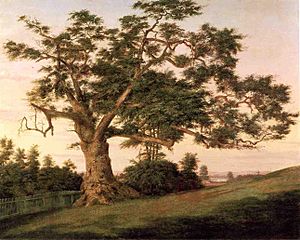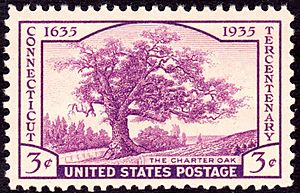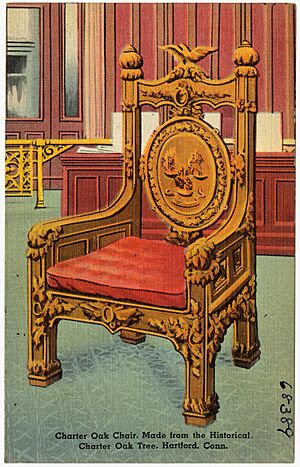Charter Oak facts for kids
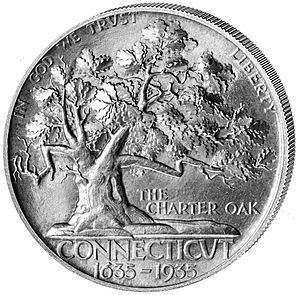
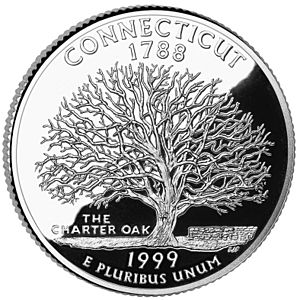
The Charter Oak was a very large white oak tree. It grew in Hartford, Connecticut, in the United States. This famous tree lived for many centuries, from about the 1200s until 1856. It fell during a big storm that year.
The Charter Oak is famous because of a special story. People say that Connecticut's Royal Charter of 1662 was hidden inside its hollow trunk. This was done to stop an English governor from taking it away. The tree became a strong symbol of American freedom. Today, you can see the Charter Oak on the Connecticut State Quarter. In 1935, it was also shown on a special coin and a postage stamp. This was to celebrate Connecticut's 300th birthday.
Early Life of the Tree
A Dutch explorer named Adrian Block wrote about a large tree in 1614. He saw it where Hartford is now. Many people believe this was the Charter Oak.
In the 1630s, local Native Americans spoke to Samuel Wyllys. He was an early settler who owned the land around the tree. They asked him to protect the tree. They said their tribe had planted it long ago as a sign of peace.
The Charter Incident
The name "Charter Oak" comes from a famous local story. This story says that a hole inside the tree was used to hide the Charter of 1662. This happened in late 1687.
Here are some facts about the charter:
- In 1662, King Charles II gave the Connecticut Colony a lot of freedom.
- His son, King James II, wanted more control. So, he combined several colonies into the Dominion of New England in 1686.
- He chose Sir Edmund Andros to be the governor-general. Andros said that his new role meant the colonies' old charters were no longer valid. He traveled to each colony to collect their charters. He wanted to physically take the documents.
- Andros arrived in Hartford in October 1687. People in Hartford did not want him to take their charter.
The most popular story says this happened on October 31, 1687. Governor Andros demanded the charter in a room at Zachariah Sanford's tavern. The document was brought out. But then, all the candles suddenly went out! In the darkness, Captain Joseph Wadsworth quickly took the parchment charter. He passed it out a window and hid it inside the Charter Oak.
Some people in 1900 thought that a copy of the charter was secretly swapped for the real one in June 1687. They believed the original was hidden in the oak even earlier. This was to make sure Andros would not find it if he searched buildings.
The Museum of Connecticut History believes that Andros never got the original charter. They display a parchment they say is the real one. The Connecticut Historical Society has a small piece of it.
Andros was removed from power in Boston two years later. This happened during the 1689 Boston revolt. The Dominion of New England then ended.
Relics from the Tree
A very strong storm blew down the Charter Oak on August 21, 1856. After it fell, people used its wood to make many things. Several chairs were made and are now in the Hartford Capitol Building. The desk of the Governor of Connecticut was also made from this wood. So were the chairs for the Speaker of the House and the President of the Senate.
A famous painter named Frederic Church was from Hartford. He also made a chair from the Charter Oak. You can still see it at his old home.
A special wooden baseball was made from the Charter Oak. It was given to the Charter Oak Base Ball Club of Brooklyn in 1860. A walking stick made from a branch of the tree was given to President Andrew Johnson in 1868.
In Literature
The writer Lydia Sigourney wrote a poem about this tree. It is called "Wyllys' Hill and the Charter Oak." She published it in her poetry book in 1827. She wrote the poem after the last owner from the Wyllys family died. This family had owned the land since the first settlers arrived.
See also
 In Spanish: Charter Oak para niños
In Spanish: Charter Oak para niños
- List of individual trees


